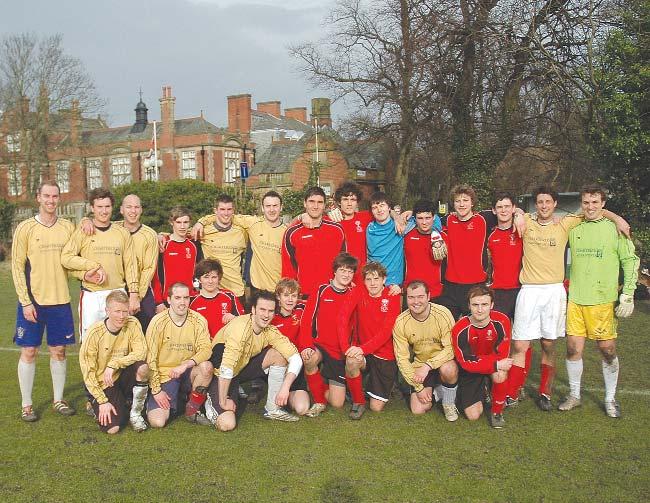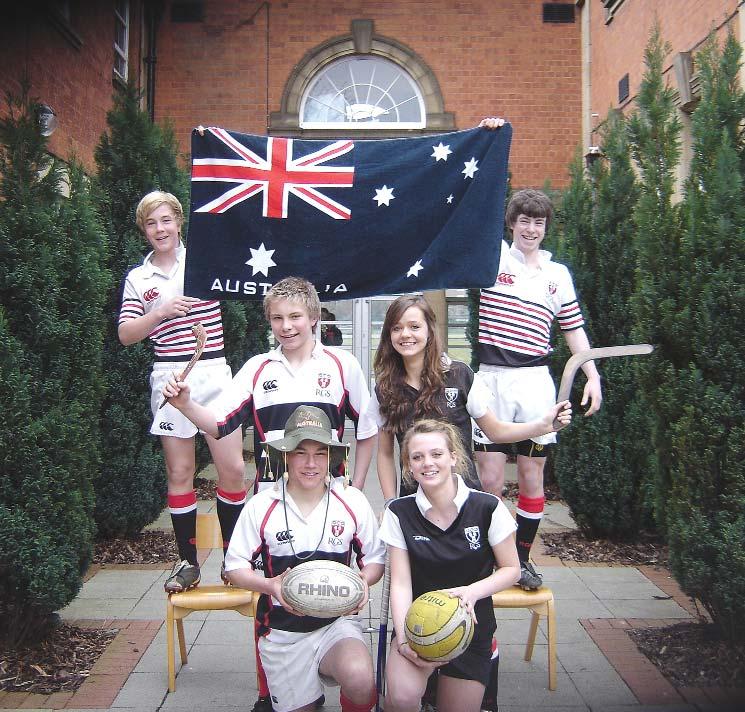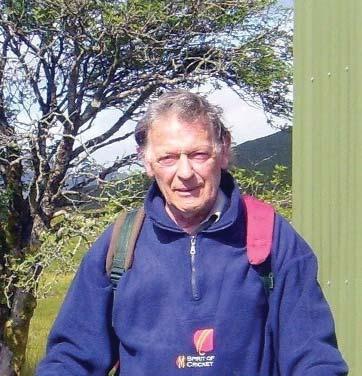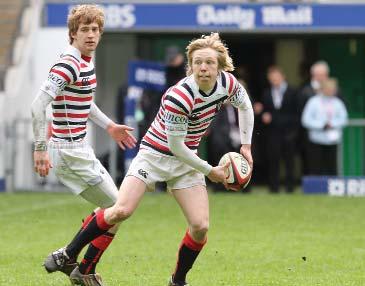
7 minute read
Apaches in Afghanistan
from ONA 79
Earlier this year, Major Tom Hargreave (83-90) who commands 654 Squadron of the Army Air Corps, invited Mike Downie, Head of Careers at RGS, and 20 students to the snowy terrain of Otterburn Rangers. There they met an iconic piece of hardware from the war against terror: the Apache helicopter.
Mike Downie writes: The Apache is a robotic gunslinger from the Westerns, hip holsters bristling with weaponry, arms akimbo ready for the draw: cold and menacing. But its US builders named it after the ‘other side’ in the Wild West, a diverse group of indigenous tribes noted for their fighting skills and stamina, a set of peoples the Spanish settlers grouped indiscriminately as Apache. Introduced to the AAC in 2001, the Apache’s role is primarily to hunt and destroy hostile military threats on the ground. Powered by twin Rolls-Royce engines, the two-crew UK-spec aircraft can operate at up to 330 km/h, armed with a mix of 16 Hellfire air-to-surface ‘fire and forget’ missiles, 76 CRV7 rockets, four air-to-air missiles and a chain gun beneath the fuselage with a capacity of up to 1200 rounds. Its suite of defensive aids includes the distinctive Longbow radar dome above the main rotor and a range of other equipment to give the crew the best means of both achieving their targets and defending themselves and their £24 million machine.
Advertisement
The RGS group was given complete access to the machine with a fascinating explanation of its systems. Hopes of seeing a live firing exercise were dampened by the severe winter weather which had upset Otterburn’s ground operations (the Apache is ‘all-weather’) but there was compensation as two machines were towed out of the hangar and one took off on a training sortie.
Of most interest to readers of this publication will be Major Tom Hargreave’s post-RGS career and it is better told in his own words:
My first experience with the Army was in the sixth form. I joined X Company of the Northumberland Fusiliers as a private soldier. It seemed a better option than cadets as it was harder and you got paid, £16 a day! My time in the Fusiliers was great fun and I learnt many soldiering skills but I learnt more about people than anything else. My relatively narrow experience of life had not put me in close quarters with men who were second generation unemployed or illiterate. I seemed to be humoured by my fellow soldiers and my ability to write postcards to various Nans when we were overseas was appreciated.
Whilst at the RGS, I took the opportunity to visit the Royal Tank Regiment and the Army Air Corps. The tanks appealed to my bent for machinery and agriculture. There is a lot to be said for charging about at 40 mph across rough country in a 70 tonne tank. Better still, was a small band of Army people who cut about in helicopters. I did not have a huge passion for flying but it occurred to me that if I could combine the humour and banter of Army life with something as flashy as flying a helicopter it had to be worth a punt. Ultimately it was a boyish enthusiasm which drove my choice of career.
I attended some odd computer tests where it was deemed I was ‘average’ with shades of ‘low average’ which apparently was good enough. After a couple of gentle interviews I was put forward for three weeks of flying grading. I had just left school and attended grading in the uniform of a private Fusilier soldier which earned me some odd looks as this course is normally reserved for Officers and Non Commissioned Officers. Flying grading consists of 13 hours of flying an aeroplane and is designed to assess your ability to learn. When the final interview with the Chief Flying Instructor (CFI) came, as the junior man by some margin, I was at the back of a 13 man queue.
During the course I had endured the crew room monologues of the other candidates who wowed us all with their amazing feats of aerobatics. I was not able to contribute to these séances as my instructor did not seem to think I was up to anything like that. After 12 glum faces had marched out of the CFI’s office I was pretty sure that my shy at a career as an Army Aviator was over. Not so said the CFI, who confirmed my ‘average’ ability and congratulated me on passing grading!
Later I also passed the Regular Commissions Board, the entry test to get into the Regular Army as an Officer. I proceeded to go to university in Newcastle which went well socially but less well academically. When it became all too clear that tertiary education and I were not well suited, my grandmother commented that “It is my job to ensure that the officers and soldiers I work with progress in life as best they can. It is hugely rewarding to plant the seed of ambition in a young soldier and see him promoted, earn more money, become better and more confident.”
Major Tom Hargreave

‘at least you have learnt how much you cannot drink’ –an alarmingly accurate insight for someone who was not there. Next came a year at the Royal Military Academy Sandhurst. This is a truly inspiring place steeped in history and valiant deeds. I enjoyed the year there and made some great friends.
In 1996 I started the year-long Army Pilot Course 866. It was an awesome course. I still remember vividly a solo sortie when I taxied past dispersal in my Gazelle helicopter seeing a student being taught how to do the pre-flight walk around inspection. And there I was flying the thing on my own! After the pilot course I was selected to fly the Lynx Helicopter, a twin engine utility machine that has amazing handling characteristics which enable it to loop the loop and do barrel rolls.
I served two years in Suffolk as a Lynx pilot in an Air Mobile Brigade. From there I was posted to Northern Ireland, and this is where I really learnt to fly. I would confidently stick the Lynx on a tiny hill top pad using night vision goggles in rubbish weather with no bother. Life was good there. A multi aircraft dawn raid on some miscreant’s house followed by more patrols, back to base, de-kit, and off to the north coast for a spot of surfing. I left with a cynical view on what religion creates.
In 2001 I became Aide de Camp to the Chief of the General Staff, Sir Mike Walker, who went on to become Chief of the Defence Staff. It was a busy time in Whitehall, as not long after I took on the job the 9/11 atrocity occurred. This had an immediate effect on our work and the General has been a regular contributor to the Chilcot Inquiry as a result.
Two years later I was back in the cockpit in support of UK Counter Terrorist Operations. I was in charge of six helicopters and a small band of highly experienced aviators. We had amazing autonomy and with that, great responsibility. By this time, domestic counter terrorist operations were quite the thing so we had plenty to keep us busy. I came close to killing myself by having a very misguided encounter with some clouds and the Cairngorms. I accumulated a lot of stuff called ‘experience’ on this tour which invariably was gained just after I could have done with it. The quality of the people, the humour and the freedom to think made this an exceptional job for me.
(In 2004, Tom landed an AAC Gazelle helicopter at RGS to give a superb careers talk to students).
In 2007 I was selected to attend training to convert to the Apache Helicopter and to command a squadron of them. It was a surreal moment as I had never envisaged that this would happen! The Apache exists for no other purpose than breaking stuff and does so in many clever ways. If you emit an electronic signal of any sort it will see you, if you are visible it will see you, if you are hidden but you are a fraction of a degree warmer than your background it will see you, if you are in an armoured vehicle or aircraft it will see you. Once it has seen you it can either tell someone else about you via data link or it can set about destroying you. It is a truly awesome machine!
It is my job to ensure that the officers and soldiers I work with progress in life as best they can. It is hugely rewarding to plant the seed of ambition in a young soldier and see him promoted, earn more money, become better and more confident. Before deploying to Afghanistan, we spent many months training in the UK and Arizona, USA. Afghanistan is a daunting prospect, but also exciting and one that I am eager to complete.
Tom Hargreave (83-90)
We are very grateful to Tom. Visiting the Apaches was hugely exciting for our group, but most thought provoking of all was meeting Tom and the AAC personnel who were so modest about the serious dangers they face on active service in Afghanistan to defend us from the global terror threat. That was truly humbling and inspiring.








